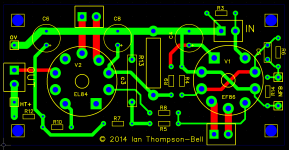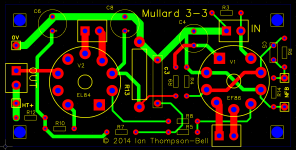All this talk about the EF86 being noisy, I have never had a problem even with high gain applications. But I never used a current production EF86 and maybe they are junk.
forgot to add in my post above - if you're a cheapskate and can get European B8A base and run the EF40 tube, which is a precursor to the EF86. Best part is the base locks in to the nub on the side of the glass (or metal for the earliest versions)


Are caps C6 and C8 mounted by the tube or under the board?
If they are by the tube I think they will toast running SE.
Regards
M. Gregg
If they are by the tube I think they will toast running SE.
Regards
M. Gregg
Are caps C6 and C8 mounted by the tube or under the board?
If they are by the tube I think they will toast running SE.
Regards
M. Gregg
They are beside the tube but neither is very tall, perhaps 25mm each. The valve footprint on the PCB is for a socket so the valve itself will about 10mm above the PCB and the first really hot bit a good 10mm above that so the two caps should not really get very hot. Having said that, there is probably room to move them a little further away.
Cheers
Ian
Hi,
The boards look good. Hope it's all to your satisfaction.
What software did you use to draw the PCB?
Bruce
The boards look good. Hope it's all to your satisfaction.
What software did you use to draw the PCB?
Bruce
Pcbs arrived a few days ago. VVT transformer set arrived this morning. Time to start building.
Cheers
Ian
It will be interesting to see how it goes..🙂
Are you going to use the feedback to reduce the gain?
Regards
M. Gregg
Last edited:
Hi,
The boards look good. Hope it's all to your satisfaction.
What software did you use to draw the PCB?
Bruce
I use FreePCB:
FreePCB: freeware PCB layout software
Cheers
Ian
It will be interesting to see how it goes..🙂
Are you going to use the feedback to reduce the gain?
Regards
M. Gregg
I am going to use the feedback primarily to reduce the distortion but it will reduce the gain as well. I do not need a lot of gain as I shall be feeding it with a +4dBu pro level signal via an input isolation transformer.
Cheers
Ian
Will you make your own PCB's or get them made.why did you opt for a PCB rather than point to point?
Re last post-by this do you mean using a transformer to reduce the line level of the input or in between/in place of the FB resistor/cap?
I've read that the EF86 can be sensitive to high input signals. As others have said the are plenty of alternative pentodes to use in the front end,but not sure Ian is overly concerned about this.That said the EF37A can be a good replacement pentode for the EF86.
Andy.
Re last post-by this do you mean using a transformer to reduce the line level of the input or in between/in place of the FB resistor/cap?
I've read that the EF86 can be sensitive to high input signals. As others have said the are plenty of alternative pentodes to use in the front end,but not sure Ian is overly concerned about this.That said the EF37A can be a good replacement pentode for the EF86.
Andy.
Will you make your own PCB's or get them made.why did you opt for a PCB rather than point to point?
I designed the PCBs and had them made by Iteadstudio.com. 10 PCBs for less than £20.
I am no good at mechanics. I hate making holes in a chassis, especially big ones. I have arthritis in my hands and I find using a Q-max punch quite painful. So I prefer PCBs. The plan is to build a stereo amp in a 3U rack mounting enclosure
Re last post-by this do you mean using a transformer to reduce the line level of the input or in between/in place of the FB resistor/cap?
Not to reduce the line level but to convert it from balanced to unbalanaced. It will be followed by a level pot.
I've read that the EF86 can be sensitive to high input signals. As others have said the are plenty of alternative pentodes to use in the front end,but not sure Ian is overly concerned about this.That said the EF37A can be a good replacement pentode for the EF86.
Andy.
It is possible that the sensitivity of the 3-3 as designed may be too high for my needs. If that proves to be the case I will experiment with increasing the NFB to further reduce the distortion. The advantage of the EF86 being directly coupled to the EL84 is that is reduces the number of poles in the loop by one which should allow more NFB without stability problems.
Cheers
Ian
Reply to a very olde post. But the pole on the pentode connected EF86/Z729 screen may not be where you expect it.I designed the PCBs and had them made by Iteadstudio.com. 10 PCBs for less than £20.
I am no good at mechanics. I hate making holes in a chassis, especially big ones. I have arthritis in my hands and I find using a Q-max punch quite painful. So I prefer PCBs. The plan is to build a stereo amp in a 3U rack mounting enclosure
Not to reduce the line level but to convert it from balanced to unbalanaced. It will be followed by a level pot.
It is possible that the sensitivity of the 3-3 as designed may be too high for my needs. If that proves to be the case I will experiment with increasing the NFB to further reduce the distortion. The advantage of the EF86 being directly coupled to the EL84 is that is reduces the number of poles in the loop by one which should allow more NFB without stability problems.
Cheers
Ian
- Home
- Amplifiers
- Tubes / Valves
- Mullard 3-3 PCB


